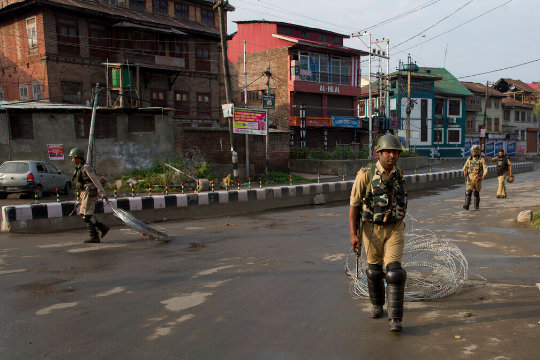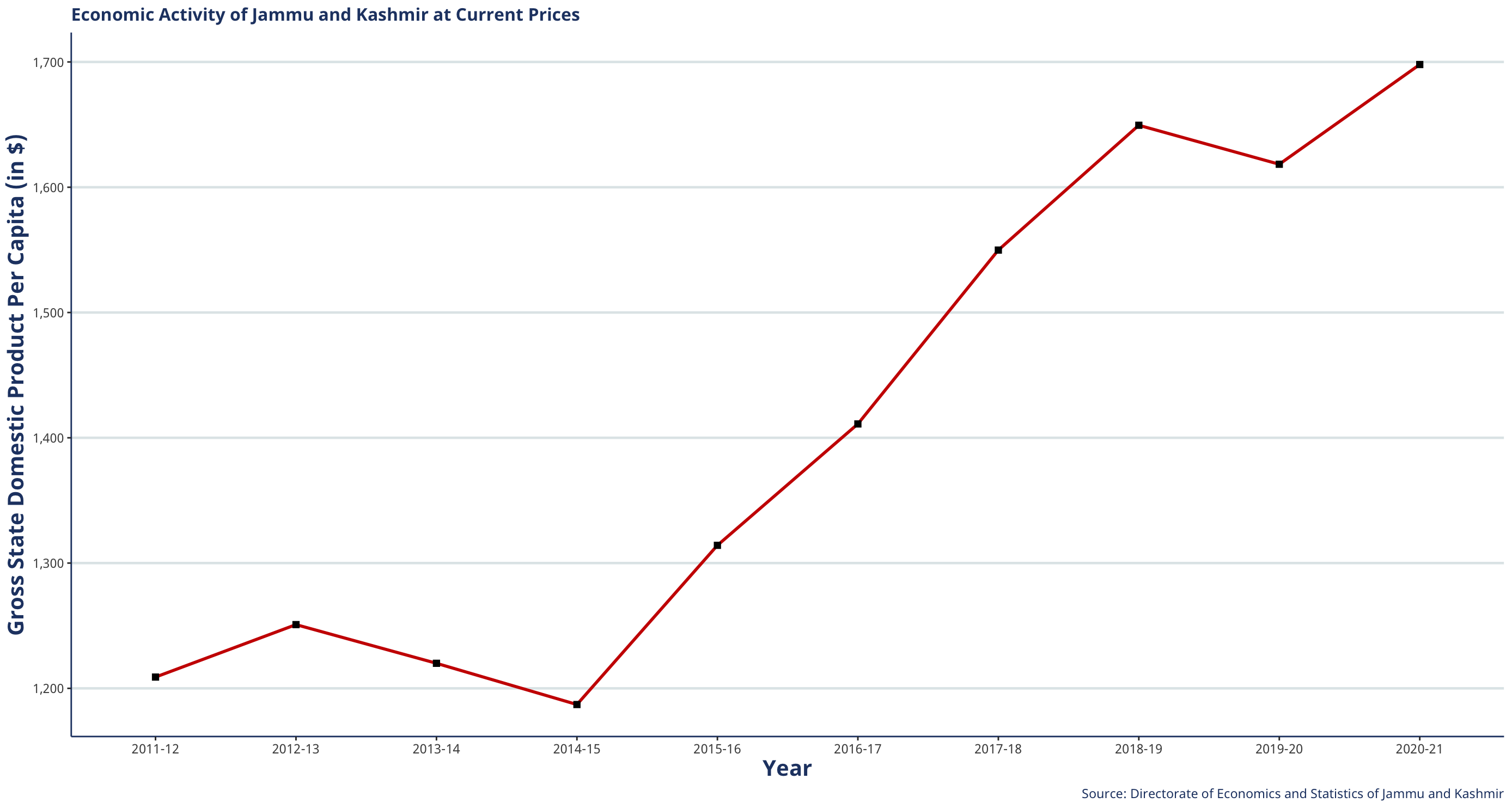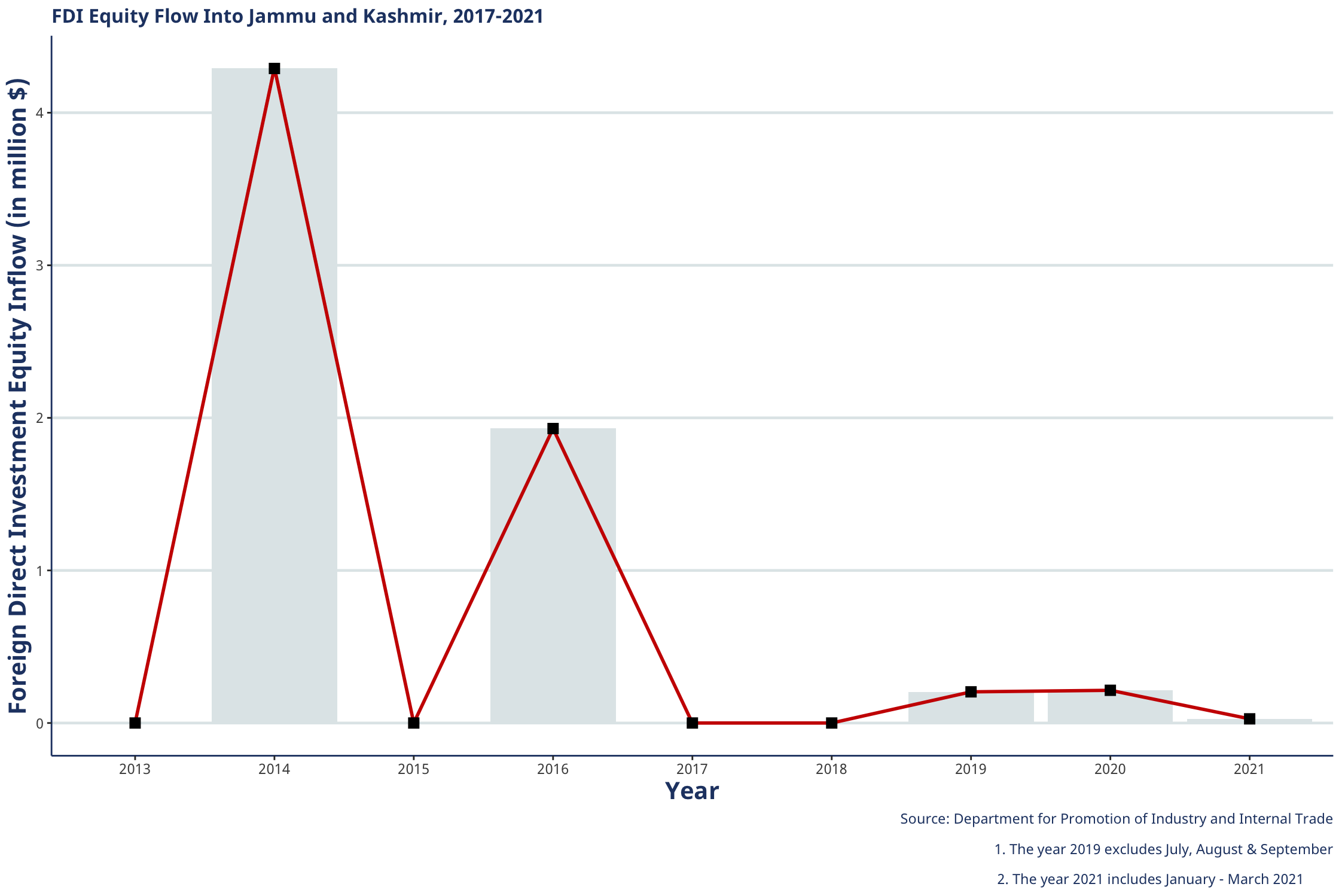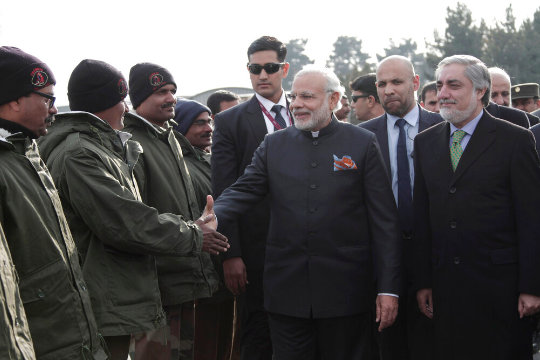| August 6, 2021 | dri.thediplomat.com |
| Groundhog Day in India-Administered Kashmir | ||||||||
|
Welcome to the all-new newsletter of Diplomat Risk Intelligence, the consulting and research division of The Diplomat, your go-to outlet for definitive analyses from and about the Asia-Pacific. Each week, DRI Asia Review will focus on a single country, subregion, or theme, based on in-house research, new DRI products, and regional media monitoring. It has four sections. The Big One offers DRI’s assessment of a major security, geopolitical, or economic issue. Babel is analysis based on translations of articles in regional newspapers and media outlets by a DRI team specializing in major Asian languages. In From Our Stable, you will find analysis based on new DRI products, short excerpts from them, or new multimedia features. And finally, each week Digestif will highlight a concept – from science, technology, economics and even philosophy – that will help you up your analytical game, irrespective of your professional interests. This week’s DRI Asia Review looks at India-administered Kashmir on the second anniversary of the revocation of its constitutionally protected status by the Indian government. By way of concluding that despite the Modi government’s tough rhetoric on Kashmir it increasingly looks like business-as-usual in the disputed region, we look at Kashmir through the lens of the region’s economy, India-China-Pakistan relations and the twists and turns of the Modi government since August 5, 2019. Could Afghanistan – like Kashmir – also emerge as an India-Pakistan battleground, especially if both countries conclude that it is “safer” to fight there than in Kashmir? And finally, Modi’s Kashmir and Pakistan policies as examples of political moral hazard? | ||||||||
Jettisoning Article 370: Two Years Later | ||||||||
| Indian Paramilitary soldiers drag barbwire as they prepare to impose curfew in Srinagar, Indian controlled Kashmir, Wednesday, August 7, 2019. | ||||||||
| — AP Photo, Dar Yasin | ||||||||
Two years since the effective abrogation of Article 370 of the Indian constitution, it is back to the future when it comes to Kashmir. The constitutional provision guaranteed a special status to the disputed state of Jammu and Kashmir within India’s federal framework. It theoretically allowed the state administration a certain degree of autonomy not provided to other states in mainland India -- autonomy, that in any event, had significantly eroded over the years. On August 5, 2019, not only did the Narendra Modi government revoke Jammu and Kashmir’s constitutionally privileged status, but it also carved out a separate federally administered territory of Ladakh from it, while downgrading the state’s status itself to a union territory. Two years later, questions abound: why the Modi government did what it did, what it had hoped to achieve from the August 5, 2019, decisions, and ways in which it has failed in what it set out to achieve – and ways in which it has succeeded. While it is undoubtedly true that revocation of Article 370 was a long-standing goal and electoral promise of the Modi’s Bharatiya Janata Party (BJP) – a promise that was reiterated in the party’s election manifesto ahead of the April-May 2019 general elections – the decision to revoke Jammu and Kashmir’s special autonomous status went beyond simple fulfilment of poll promises. Instead, the decision had much to do with how the Modi government found itself grappling with a long-persistent conundrum in Kashmir, an extremely vital strategic theater where conventional military threats from neighboring China and Pakistan meet a three-decade long insurgency -- and all of which sits on top of a convoluted history of 74 years. The best account of how the Modi government sought to wield the Article 370 revocation sword to manage Kashmir’s multiple internal and external security problems remains Ashok Malik’s 2019 think tank paper, published two days after the August 5 decision and based on his conversations with government officials. Malik -- a pro-BJP journalist and think tanker who had served as the Indian president’s press secretary and now works in the Indian foreign ministry as a senior policy advisor --situated Modi’s decision within India’s security calculus vis-à-vis both Pakistan as well as the insurgency in Kashmir which had threatened to boil over by the summer of 2016. But interestingly enough, Malik also described the impending return of the Taliban in Afghanistan, and in a August 2019 op-ed, also alluded to China as being part of Modi’s Article 370 calculations. “In the coming decade, if India acts strategically in Ladakh and builds appropriate capacities, some of the Chinese investments and assumptions [in Gilgit-Baltistan through the China-Pakistan Economic Corridor, Xinjiang and Tibet] could be at risk,” Malik wrote in his August 2019 newspaper piece. This line of thinking has led some analysts to claim that the Chinese – alarmed by Indian rhetoric and faced with a strategic opportunity – decided to embark on a military operation across a large frontage in eastern Ladakh early last year. The operation played out as effectively shifting the Line of Actual Control (a de-facto though undefined boundary that separates China and India) at many locations in favor of China. Despite modest progress in resolving it, the ensuing standoff continues till date, more than a year after it started. On paper however, the Modi government has framed the August 2019 decisions in terms of economics and not geopolitics and security, claiming that the move would support increased development and social equity in Jammu and Kashmir. But those claims remain questionable. For one, the state’s per capita Gross Domestic Product has steadily climbed over the past decade -- and even before the decisions two years ago – obviating the need to take dramatic decisions on purely economic grounds. Other economic indicators tell a congruent story. Take, for example, Foreign Direct Investment (FDI) equity flows into Jammu and Kashmir over the past eight years. Looking at the numbers, it is clear that there is no discernible link between those numbers and the security environment in the erstwhile state. For example, FDI equity flow actually increased between 2019 and 2020, despite the Pulwama terrorist attack of February 2019 which almost sparked a war between India and Pakistan after New Delhi retaliated with airstrikes on mainland Pakistan. When it comes to Pakistan too, India is slowly inching back to its traditional mode when it comes to dealing with the country’s archrival -- which is a preference for engagement (overt or covert) punctuated by harsh rhetoric and bickering in multilateral fora. In February this year, both countries recommitted themselves to an informal 2003 ceasefire. Around that time news also emerged that they had established a secret channel for talks two years ago. And finally, Modi seems to be once again willing to bring mainstream Kashmiri politicians back to the fold, as witnessed by his June meeting with them in New Delhi. It now looks quite likely that Jammu and Kashmir’s statehood would be restored by the end of Modi’s second term in office in 2024. The good news for Modi – and this is where his government had indeed performed admirably – is that since the decisions of August 2019, the Kashmir valley has not seen a surge in violence, as many had feared. At the same time, terror groups operating there are at a disarray, and the level of insurgent activitylow (relatively speaking, of course). Bottomline: India-administered Kashmir is well on its way towards business as usual. | ||||||||
| Asia-Pacific Cyber Risks Stay tuned for a new DRI Monthly Report that surveys the Asia-Pacific cyber risks landscape. The report, drawing on primary and secondary research as well as expert consultations, surveys the geopolitical and commercial forces shaping Asia’s approach towards cybersecurity and the role of the COVID-19 pandemic in consolidating emerging cyber trends. It also highlights areas of critical importance for governments and businesses allowing them to act on tomorrow’s challenges today. | ||||||||
A Fresh Start for Kashmir? | ||||||||
| A Kashmiri prepares to catch a stone during an anti-India protest Srinagar, India, Friday, Aug. 9, 2019. | ||||||||
| — AP Photo, Altaf Qadri | ||||||||
Meanwhile, supporters of the Modi government’s August 2019 decision continue to maintain that the decision to revoke Jammu and Kashmir’s autonomy has paved the way for a complete rehaul of the erstwhile state, and for the better. In an August 5 opinion piece in Dainik Jagran, a leading Hindi newspaper, Rasal Singh, a professor in Jammu University said that the move not only stands to help marginalized groups in Jammu and Kashmir but has also ensured that the state’s developmental future is now secure. Rife with familiar (and not entirely off-the-mark) past grievances, such as longstanding discrimination against Kashmiri Hindus and women, his piece also pointed out the decline in insurgent violence in Kashmir over the past two years. He also reminded readers of the Modi government’s commitments to Hindus who were forced out of Jammu and Kashmir due to a surge in Islamist violence since the 1990s. R. Vikram Singh, a former bureaucrat, concurred in another opinion piece on August 5, published in Amar Ujala, another popular Hindi newspaper. In Singh’s telling, the original sin that led to Article 370 in the first place was committed by India’s first Prime Minister Jawaharlal Nehru – a trope common among Hindu nationalists. Interestingly (though unsurprisingly), he concluded his piece with a call to regain Pakistan-administered Kashmir and Gilgit-Baltistan. “PoK [Pakistan-administered Kashmir] is part of India and we expect one day that we will have the physical jurisdiction over it,” Indian External Affairs Minister S. Jaishankar had said in September 2019. While it is easy to dismiss voices such as Rasul Singh and R. Vikram Singh as parroting the Modi government’s line, the fact of the matter remains that Kashmir has, for decades, been run by rent-seeking politicians who have thrived on the region’s disputed status. But more importantly, such voices are more common in India than what New Delhi’s liberal elites would care to admit. The real risk for BJP supporters lies with the fact that the Modi government might indeed not go far enough with its original promises following the revocation of Jammu and Kashmir’s autonomous status. If anything – as noted earlier – the Modi government may indeed restore the now union territory’s status as a state, a key demand of the Gupkar alliance of local Kashmiri political parties. That is sure to disappoint ardent Modi fans. But will such a decision carry political costs for the prime minister and the BJP in 2024? Unlikely. | ||||||||
Afghanistan: A New Front in India-Pakistan Proxy War? | ||||||||
| Indian Prime Minister Narendra Modi shakes hands with Indian technical personnel at Kabul airport, December 25, 2015. | ||||||||
| — AP Photo, Rahmat Gul | ||||||||
Following the February India-Pakistan ceasefire, a fragile peace now holds between the two countries. But should that peace be shattered, could Afghanistan emerge as a battlefield for New Delhi and Rawalpindi? To be sure, India has – and not without justification – accused Pakistan of orchestrating attacks on its facilities in Afghanistan. And in this, India is not alone: Afghan police have gone on record blaming Pakistan for a 2016 attack on the Indian consulate in Mazar-e-Sharif. In turn, Islamabad has, rather incredulously, accused India of spreading terror in Afghanistan, and of using that country to maintain covert pressure on Pakistan. Indeed, for a long time, Pakistan’s search for “strategic depth” – a scenario where a Pakistan-friendly government in Kabul does not allow India influence in Afghanistan, military or otherwise – has motivated the country’s Afghan policy. In a January DRI Monthly Report (ungated), longtime analyst of Pakistan Ayesha Siddiqa described a scenario where Afghanistan emerges as a key site of Indian-Pakistan proxy warfare sometime in the near future. She wrote: “…Afghanistan offers greater space for conflict between India and Pakistan: the presence of multiple competing interests, varied global militant networks that operate alongside the Taliban as it competes for dominance of the entire territory, and plausible deniability for both if they were to engage in a proxy war in Afghanistan. While Pakistan can claim its troops are not directly involved in Afghanistan and can operate, instead, through proxies, India could make similar claims of detachment by arguing that its interests are limited to providing development aid to Kabul.” The scenario Siddiqa describes as playing out is chilling – and far from implausible. | ||||||||
DRI Monthly Reports are rigorous research investigations that go beyond reportage and commentary for deep-dive analyses of timely topics and emerging trends in the Asia-Pacific. | ||||||||
Moral Hazard | ||||||||
| — Flickr, Susan Guest | ||||||||
Moral hazard, broadly speaking, refers to a situation where actors engage in risky activities under the cover of insurance. Ever since assuming office for the first time in 2014, Modi has repeatedly bet big, sometime with little thought about the second and higher order effects of his decisions. His 2016 decision to scrap 86 percent of Indian currency with a few hours’ notice to the public serves as a case in point. However, nowhere has his risk-taking appetite been more visible than in his dealings with Pakistan – and in his Kashmir policy. Witness, as but one example, the decision to abruptly neutralize Article 370. All the while, Modi has bet that Indian public perception can be deftly managed – with the aid of loyalists in media – and that there would be little political cost to his actions. When it came to Kashmir, Modi and his supporters have also calculated that international appetite for criticism of India is rapidly diminishing, given the West’s perception of their as a counterweight to China. At the very least, as long as the United States and allied powers remain preoccupied with China, India will continue to be given a free pass to reshape its domestic structures, many in New Delhi have shrewdly (and not incorrectly) assessed. Furthermore, as two analysts known to be close to the Modi government wrote in 2016, New Delhi has also calculated that the West has little patience left for Islamist extremism, opening space for it to pursue muscular policies in Kashmir with little fear of international condemnation. And finally, take India’s decision to strike Pakistan in February 2019 and ask yourself: Had war between the two countries broken out then, how likely was it that the U.S. would come to Pakistan’s aid and not India’s? The Modi government, in other words, deems itself “insured” from international pressure and domestic political costs for a variety of reasons, allowing it to do what it has done so far. Is this not moral hazard? | ||||||||
Diplomat Risk Intelligence (DRI) is the consulting and analysis division of The Diplomat, the Asia-Pacific’s leading current affairs magazine. Learn More | ||||||||
For DRI services, contact us at: | ||||||||
Follow The Diplomat on:
| ||||||||
| This newsletter was sent to [[EMAIL_TO]]. Unsubscribe | ||||||||
| Diplomat Media Inc. | 1701 Pennsylvania Ave | Washington, D.C. 20006 | USA | ||||||||
| [email protected] | thediplomat.com | ||||||||
| ©2021 Diplomat Media Inc. All rights reserved. | ||||||||









